Lake Name: Twin Lakes Elevation:
8,600
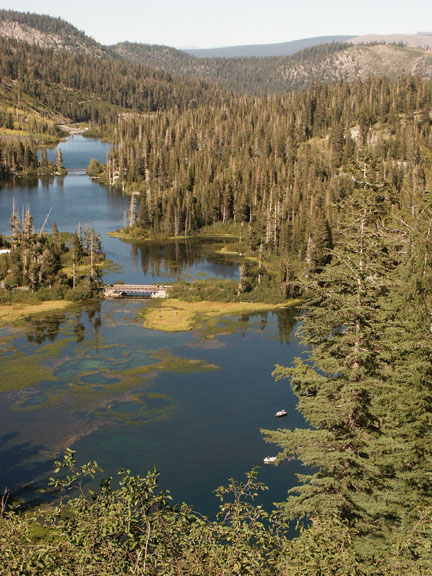
Road condition: Paved
Day hike fishing: T.J. Lake, Crystal Lake, McLeod
Lake
Region: Mammoth
Lakes Ranger District 760-924-5500
Area/description: Mammoth Lakes
Size: 30
acres Species: Rainbows, Browns and Brookies
Closest town or
supplies: Mammoth
Lakes
Contacts: Twin
Lakes Store (760) 934-6974; Mammoth Lakes Visitor Bureau (888) 466-2666 /
(760)-924-5500; Rick’s Sports
Center (760) 934-3416;
The Trout Fitter fly shop (760) 934-2517.
Facilities:
Lodge, marina, grocery store, bait and tackle, coin-laundry, coin-showers
Nearest campground: Twin Lakes
Campground; Mammoth Mountain RV Park; New and Old Shady Rest Campgrounds; Pine
Glen
Boating: Boat
launch; no gas-powered motors
Fishing season:
General Best times:
Tips:
Favorite lures or bait:
Use small lures such as Kastmasters, Daredevils and Panther-Martins. Bring smaller lures, but have a variety of
color combinations to entice both shallow and deep cruising trout. Bank anglers typically use Power Bait, night
crawlers or salmon eggs suspended above the bottom with marshmallows. (See
Category: Fishing Tips – Best Lures and Bait)
Favorite fly
patterns: : The Fly & Bubble technique with small nymphs such as Hare’s
Ear, Zug Bug, Bead-Head Prince Nymph, Pheasant Tail or a Tellico Shrimp; for
larger trout be sure to have some good streamer patterns, particularly the
Olive Matuka, Woolly Buggers and leech patterns. (See Category: Fishing Tips –
Best Fly Patterns and Techniques)
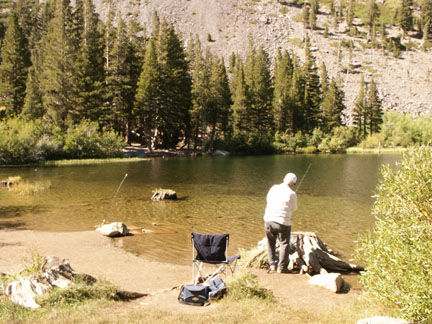
Stocking information:
20,000 plus yearly carry-overs
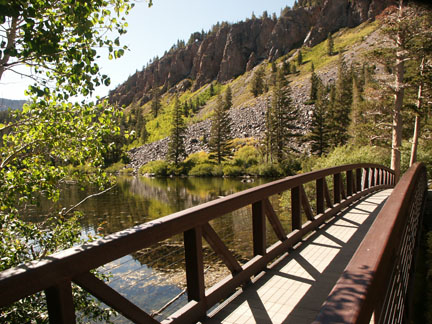
Additional information:
High pressure
Nearby fishing: Lake Mary, Mamie Lake, Lake George
Directions: From
Highway 395 turn west at the junction with Highway 203 and drive through Mammoth Lakes.
Turn onto Lake Mary Road. Drive 2.3 miles to Twin Lakes.
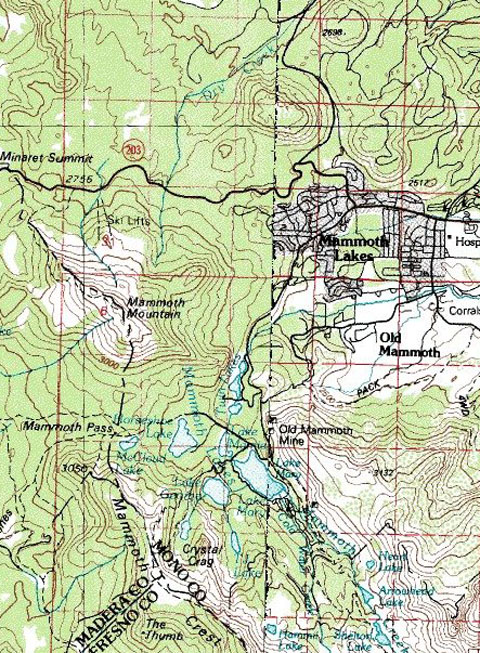
Map courtesy of mytopo.com.
Mammoth Lakes: Permit an aging angler to wax
nostalgic. As a young boy attending Bishop
Elementary School as a
third grader, I soon discovered the children’s only fishing area at one of the
parks. Borrowing my father’s South Bend fly rod, I
headed for the park on a beautiful fall afternoon. Using a stick to dig with, I soon pulled up a
number of earth worms and grubs, which I deposited in my hinged worm can that
could be worn from a belt. Walking the
bank, I soon found my elusive quarry fining below a large, swaying water cress
plant. I had no idea how to cast an 8’ fly rod, and my frustration soon got the
better of me when I saw the trout dart away to a new hiding place. A few older boys gathered behind me on the
bank. I looked up to see one of Doc
Wilson’s older sons. “Do you need some
help?” he asked.
I lowered
my rod with a dejected sigh. “Yeah, but
I want to catch a fish all by myself,” I replied.
“Well,” the
oldest boy grinned, “I can help you do that.
I’ll just get your worm out there in the water, but you’ll have to catch
the fish.”
“OK!” I
said, eager to begin a fishing lesson that my father had failed to initiate after
many requests. I followed the older boy
downstream to where a fence crossed the small channel. We crawled on our hands and knees the last
few yards. Peeking through the grass on
the bank above the water, we could see a couple of trout feeding right under
the wire fence. The older boy flipped
the worm out in the water and handed the rod to me. “Now, shake out some line. Just lift your rod a little and point it
downstream. Shake it a little more.”
I couldn’t
believe my eyes. The red worm, neatly
skewered on an Eagle snelled hook, gradually worked down to the feeding
trout. One of the trout darted over to
the worm and greedily swallowed it. I
didn’t have to be told how to set the hook.
I was on my feet running backwards.
The little Rainbow never escaped the hook until I had him half-way on to
the playground. The other boys laughed
with glee, and so did I when I ran home to show my mom my first trout. Later, when I was in junior high, I spent a
week or more fishing Mammoth Lakes and Rush
Creek. I caught a dozen trout every day. I probably had no idea what the limit was,
but my mother’s imposed limit was simply you ate what you caught that day
because she wasn’t about to let trout pile up in our camping ice box.
In 1959 the
mantra “Catch-and-Release” had not been coined.
I was in ninth grade, and I had just sold my bicycle, cleaned out my
Piggy bank and bought my first boat. It
was a Fold-A-Boat, a leaky old plywood and canvass ten foot pram that I
christened the “Twilight Wanderer.” Each
day I would row out on Twin
Lakes with a peanut
butter sandwich wrapped in wax paper, a water jug and a bailing bucket. My spinning rod was a Berkley
and my spinning reel was a Langley
777. My only lures were red and white
Daredevils. When I saw my mother open up
the trailer doors on our little 15-foot camper and let my sisters out to play in
the morning, I knew it was time to head in with my catch for a hearty trout
breakfast. My father had died the
previous summer. This trip to my
father’s home area was a trip we had planned with my father a year earlier. My mother cooked trout as a side dish every
night for me. It was a glorious fishing
trip.
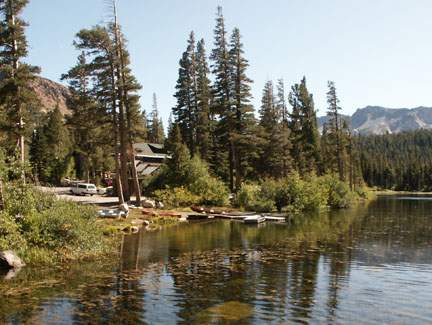
Mammoth Lakes
is a world class destination resort offering recreation all year. Trendy shops, 4-Star restaurants, world class
skiing and public camping nearby makes this community a fun place to
visit. Add great fishing and you will
understand why it is LA’s favorite playground.
Mammoth Lakes comprises nine lakes in close
proximity to each other. Five of these
lakes are reached by paved road, and the remaining lakes may be reached in
short hikes or day hikes. Lake Mary is
the largest at 140 acres, and a road circles the lake with access to Mamie Lake, Horseshoe Lake
and Lake George. From Lake George hiking trails lead to T.J. Lake
and Crystal Lake. Barrett
Lake is barren and Horseshoe Lake
should probably be avoided due to the posted health warnings for high
admissions of Co2 from volcanic fissures.
Sure, trout still survive in small numbers, but do you really want to
spend time around an odorless gas that harms plant life and animal life? McLeod
Lake trailhead may be reached from the
Horseshoe Lake parking lot. McLeod
Lake is a short half-mile
hike up the trail. My sentimental
favorite, however, is Twin
Lakes, the first lakes to
be reached on Lake Mary Road. The Mammoth
Lake area also features Convict Lake,
Crowley Lake
and Laurel Lakes.
If your only association for Mammoth is world-class skiing, think again!






Leave a comment